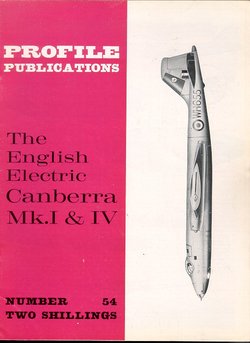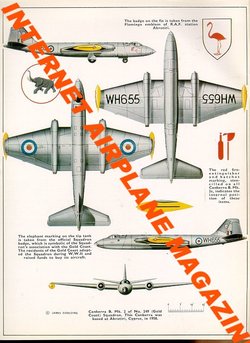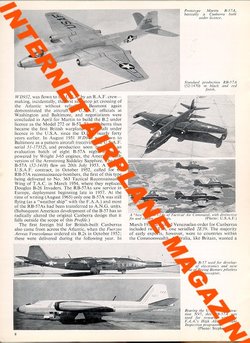AIRCRAFT PROFILE 54 ENGLISH
ELECTRIC CANBERRA MkI & MkIV MARTIN B-57A RB-57A USF
-----------------------------------------------------------------------------------------------------------------
Additional
Information from Internet Encyclopedia
The English Electric
Canberra is a British first-generation jet-powered medium bomber
manufactured in large numbers through the 1950s. The Canberra could fly at a
higher altitude than any other bomber through the 1950s and set a world
altitude record of 70,310 ft (21,430 m) in 1957. Due to its ability
to evade the early jet interceptors and its significant performance advancement
over contemporary piston-engined bombers, the Canberra was a popular export
product and served with air forces of many nations.
In addition to being a tactical nuclear strike aircraft,
the Canberra proved to be highly adaptable, serving in varied roles such as
tactical bombing and photographic and electronic reconnaissance. Canberras
served in the Suez Crisis, the Vietnam War, the Falklands War, the
Indo-Pakistani wars, and numerous African conflicts. In several wars, each of
the opposing sides had Canberras in their air forces. The Canberra was retired
by its first operator, the Royal Air Force (RAF), in June 2006, 57 years after
its first flight. Three of the Martin B-57 variants remain in service,
performing meteorological work for NASA, as well as providing electronic
communication (Battlefield Airborne Communications Node or BACN) testing for
deployment to Afghanistan.
The resultant aircraft, designated the Canberra B2, first
flew on 21 April 1950, piloted by Roland Beamont. Proving to be fairly free of
problems, this first flight was almost immediately followed by the
manufacturing of production Canberras, entering squadron service with RAF No.
101 Squadron in May 1951. In a testament to the aircraft's benign handling
characteristics, the transition program consisted of only twenty hours in the
Gloster Meteor and three hours in the dual-control Canberra trainer.
With a maximum speed of 470 knots (870 km/h;
540 mph), a standard service ceiling of 48,000 ft (14,600 m),
and the ability to carry a 3.6-tonne (7,900 lb) payload, the Canberra was
an instant success. It was built in 27 versions that equipped 35 RAF squadrons,
and was exported to more than 15 countries, including Australia, Argentina,
Chile, Ecuador, Ethiopia, France, India, New Zealand, Pakistan, Peru, Rhodesia,
South Africa, Sweden, Venezuela and West Germany.
The strategic reconnaissance role within the RAF had been
carried out by the de Havilland Mosquito; in 1946 the Air Ministry issued
Specification PR.31/46 as a jet-powered replacement for the Mosquito. To meet
the requirement, the B2 design was modified by adding a 14-inch (36 cm)
bay forward of the wing behind the cockpit to house seven cameras. It also had
an additional fuel tank in the forward part of the bomb bay and only needed a
two-man crew. The prototype, designated PR3, first flew on 19 March 1950,
followed by the aircraft on 31 July 1952. It entered
service in December 1952 when No. 540 Squadron RAF began to convert from the
Mosquito PR.34. The Canberra PR3 was the first aircraft designed for the RAF
purely for PR.
To enable crews to convert to flying the Canberra, a
trainer version was developed to meet Air Ministry Specification T2/49. The
prototype designated T4 first flew on 12 June 1951. It was the same basic
design as the B2 apart from the introduction of side-by-side seating for the
pilot and the instructor and the replacement of the glazed nose with a solid
nose. The first production T4 flew on 20 September 1953 and the variant entered
service with No. 231 Operational Conversion Unit RAF in early 1954. As well as
the operational conversion unit, all the B2-equipped bomber squadrons received
at least one T4 for training.
Thrust was provided by a pair of 30 kN axial flow
Rolls-Royce Avon turbojets. The manufacturer specified that Coffman engine
starters should be used to start the engine. An improvised method of starting
the engine using compressed air was heavily discouraged by Rolls-Royce, but
some operators successfully operated the Canberra's engines in such a manner,
the benefit being significant cost savings over cartridges. The aircraft's maximum
take-off weight was a little under 25 tonnes.
The Canberra could deploy many conventional weapons,
typical weapons used were 250-pound, 500-pound, and 1000-pound bombs, the total
bomb load could weigh up to 10,000 pounds (4.5 t). Two bomb-bays are housed
within the fuselage, these are normally enclosed by conventional clam-shell
doors; this was substituted for a rotating door on the Martin-built B-57
Canberras. Additional stores up to a total of 2,000 pounds (0.91 t) could
be carried upon underwing pylons. Operators often developed and installed their
own munitions, such as Rhodesia's anti-personnel bomblets, the Alpha bomb, a varied range of
munitions were employed on Canberra fleets around the world. Anti-personnel
flechette bombs were tested successfully from the Canberra by Rhodesia, but not
used operationally due to international agreements.
In part due to its range limitation of just 2,000 miles
(3,200 km), and its inability to carry the early, bulky nuclear bombs, the
Canberra was typically employed in the role of a tactical bomber as opposed to
that of a strategic one. In British service, many of the Canberras that were
stationed at remote overseas locations did not undertake modifications to
become nuclear- capable until as late as 1957.
The Canberra B2 started to enter service with 101
Squadron in January 1951, with 101 Squadron being fully equipped by May, and a
further squadron, No. 9 Squadron equipping by the end of the year. The
production of the Canberra was accelerated as a result of the outbreak of the
Korean War, orders for the aircraft increased and outpaced production capacity,
as the aircraft was designated as a "super
priority". A further five squadrons were able to be equipped with
the Canberra by the end of 1952; however, production in the 1951–52 period had
only been half of the level planned, due to shortages in skilled manpower,
material, and suitable machine tools.
The Canberra replaced Mosquitos, Lincolns and Washingtons
as bombers, showing a drastically improved performance, and proving
to be effectively immune from interception during air defence exercises until
the arrival of the Hawker Hunter. The Canberra also replaced the RAF's
Mosquitos in the reconnaissance role, with the Canberra PR3 entering service in
December 1952. The improved Canberra B6, with more powerful engines and a
greater fuel capacity, started to supplement the B2s in the UK based squadrons
of Bomber Command from June 1954, when they replaced 101 Squadrons B2s. This
freed up older B2s to allow Canberra squadrons to form overseas, with bomber
and reconnaissance Canberra wings forming in RAF Germany and on Cyprus, with
squadrons also being deployed to the Far East.
The PR7 variant of the Canberra, equipped with longer,
fuel-filled wings and the Avon 109 engines, executed a 1953 reconnaissance
flight over the Soviet rocket launch and development site at Kapustin Yar,
although the UK government has never admitted the existence of such a flight.
Warned by either radar or agents inside the British government, the Soviets
damaged and almost shot down the aircraft. Further reconnaissance flights are
alleged to have taken place along, and over, the borders of the Soviet Union in
1954 under the code name Project Robin,
using the Canberra B2 WH726.
The USAF also used the Canberra for reconnaissance flights. The aircraft were
no longer required after June 1956, following the introduction of the US
Lockheed U-2 purpose-built reconnaissance aircraft; Project Robin was then terminated. These RAF Canberra overflights
were later featured in the 1994 BBC Timewatch
episode; "Spies in the Sky Included interviews with some of the
Soviet MiG-15 pilots who had attempted to intercept them.
An important role for the new low-level force was
tactical nuclear strike, using the Low Altitude Bombing System (LABS) to allow
a nuclear bomb to be delivered from low level while allowing the bomber to
escape the blast of the weapon. RAF Germany's force of four squadrons equipped
with the B(I)6 and B(I)8 could carry US-owned Mark 7 nuclear bombs, while three
squadrons based on Cyprus and one at Singapore were armed with British-owned
Red Beard nuclear weapons.
During the Suez Crisis the RAF employed around 100
Canberras, flying conventional bombing and reconnaissance missions from airfields
in Malta and Cyprus. A total of 278 Canberra sorties were flown, dropping 1,439
1000 lb (450 kg) bombs; however low-level strikes by smaller fighters
were judged to be more effective than the bombing operations
performed by both the Canberra and the Vickers Valiant. In addition, many of
the bombs, intended to hit Egyptian airfields, missed their targets, failing to
inflict much damage to the Egyptian Air Force or to badly demoralise the enemy.
While interception of the Canberra was within the capabilities of Egypt's
MiG-15s and MiG-17s, as shown by the interception of Canberras by MiG-15s prior
to the Anglo-French invasion, these did not result in any losses. The only
Canberra shot down during the Suez campaign was a PR7 shot down by a Syrian
Gloster Meteor fighter on 6 November 1956, the last day of the war .
The RAF continued to operate the Canberra after 1972,
employing it for reconnaissance (with Squadrons equipped with PR7s and PR9s
being based at RAF Wyton in the UK and RAF Luqa in Malta). The PR9s were fitted
with special LOROP (Long-Range Optical Photography) cameras, reportedly based
on those used by the Lockheed U-2, to allow high-altitude of targets deep into
Eastern Europe while flying along the inner German border, as well as infrared
linescan cameras for low level night reconnaissance. The RAF used Canberras to
search for hidden arms dumps using false-colour photography during Operation
Motorman in July 1972, when the British Army re-took Irish republican held
"no go areas" in Belfast and Londonderry. Canberras were used for
reconnaissance during the Bosnian War during the 1990s, where they were used to
locate mass graves and during the Kosovo War in 1999. They were also operated
from Uganda during the First Congo War, where they were used to search for
refugees. Small numbers of specially equipped Canberras were also used for
signals intelligence, being operated by 192 Squadron and then 51 Squadron from
1953 to 1976.
During the Falklands War, a plan to supply two PR9s to
the Chilean Air Force, and secretly operate them with RAF crews over the war
zone, was abandoned for political reasons. The aircraft got as far as Belize
before the operation was cancelled. The PR9 variant remained in service with
No. 39 (1 PRU) Squadron until July 2006 for strategic reconnaissance and
photographic mapping, seeing service in the 2003 invasion of Iraq and, up to
June 2006, in Afghanistan. During a ceremony to mark the standing down of 39 (1
PRU) Squadron at RAF Marham on 28 July 2006, a flypast by a Canberra PR9 on its
last ever sortie was conducted.
Shortly after the end of the Second World War, the
Australian government began reorganising the armed forces. The Royal Australian
Air Force (RAAF) developed Plan "D" for its postwar structure, built
around the concept of a small, agile air arm employing leading edge technology.
The RAAF decided to acquire the Canberra to replace or complement the Avro
Lincoln, though fears were raised that the new design was not especially
advanced. While Australia never introduced nuclear weapons into service, the
Canberra's ability to carry such a payload was a factor in its acquisition;
Australia's planned force of 48 Canberras, with the potential for being
nuclear-armed, was viewed as far more potent and deterring than the RAAF's
entire wartime forces of 254 heavy bombers. The first Australian-built Canberra
first flew on 29 May 1953 at Avalon and was delivered to the RAAF for service
trials a few weeks later. The Canberra entered Australian service in December
1953.
From July 1950 to July 1960, during the Malayan
Emergency, Canberras from Australia, New Zealand and the UK were deployed into
the Malaysia to fight against Communist guerillas. In 1967, the RAAF deployed
eight Canberras from a squadron of B20s to the Vietnam War. The unit, No. 2
Squadron, was later commended for its performance by the United States Air
Force. The Canberras were typically operated in the low-level bombing role,
taking over South Vietnam's military regions III and IV
responsibilities allowing USAF bombers to deploy their aircraft to the Ho Chi
Minh trail. While USAF Canberras were equipped with .50 caliber machine guns or
20mm cannon for strafing, Australian Canberras were deployed to South Vietnam
without guns, hence were deployed strictly for low level bombing missions. Upon
their re-deployment from Vietnam in 1971, No. 2 Squadron had flown
approximately 12,000 sorties and dropped 76,389 bombs, and lost two of their
aircraft to missiles and ground fire during the course of the war.
The Swedish Air Force purchased two Canberras from the
RAF in 1960 and had these modified to T11s by Boulton Paul. The aircraft were
secretly modified in Sweden as espionage aircraft for eavesdropping on
primarily Soviet, Polish and East German military radio transmissions, although
this was not publicly admitted until 10 years later. The Canberras were given
the designation Tp 52, and taken into service as "testing aircraft",
until they were replaced by two Tp 85 Caravelles in 1971.
During the Indo-Pakistani Wars of the 1960s and 1970s,
the Canberra was used by both sides. The most audacious use of the bomber was
in the "Raid on Badin"
during the Indo-Pakistani War of 1965, when the Indian Air Force sent in the
Canberra to attack a critical Pakistani radar post in West Pakistan. The raid
was a complete success, the radars in Badin having been badly damaged by the
bombing and put out of commission. A later raid by the IAF was attempted on
Peshawar Air base with the aim of destroying, amongst other targets, several
Pakistani B-57 bombers, American-built Canberras. Due to poor visibility, a
road outside of the base was bombed, instead of the runway where PAF B-57
bombers were parked.
During the Indo-Pakistani War of 1971, Indian Canberras
flew a strategically important sortie against the Karachi oil tanks, this had
the effect of helping the Indian Navy in their own operations, a series of
missile boat attacks against the Pakistani coast.
The Argentine Air Force received 10 B62 bombers and two
T64 trainers at the beginning of the 1970s, replacing the Avro Lincoln in the
bomber role. Argentina retired its last Canberras in April 2000.
During the Falklands War in 1982, eight of them were
deployed to Trelew, 670 miles (1,080 km) from the islands, to avoid
congestion on the closer southern airfields. Although within operating range of
the British task force, the Canberra was judged to be a limited threat due to
its poor maneuverability compared with the British Sea Harriers.
---------------------------------------------------------------------------------------------------------------
RARE & HARD TO FIND IN THIS CONDITION. READY TO
COMPLETE YOUR COLLECTION. FILL IN THE GAPS! NOTE- AUCTION
PROTECTION WATERMARKING ON THESE IMAGES ATTACHED TO THIS AUCTION DO NOT APPEAR
ON AUCTUAL PUBLICATION.
THIS IS A 20-PAGE SOFTBOUND BOOKLET FROM THE PROFILE
PUBLICATIONS SERIES PUBLISHED IN THE SIXTIES CONTAINING B/W PHOTOGRAPHS,
2-PAGES OF COLOR PROFILES / COLOR THREE VIEW SCALE DRAWINGS CENTERFOLD,
TECHNICAL SPECIFICATIONS, DETAILS OF DEVELOPMENT AND OPERATIONAL USE. THIS IS A CLASSIC REFERENCE BOOK ON THE
SUBJECT AIRCRAFT IT IS NOT A PLASTIC MODEL KIT.
IT
IS ALSO NOT ONE OF THE ILLEGAL AND POOR QUALITY SCANNED COPIES
OF THIS HARD-TO-FIND BOOKLET NOW APPEARING ON EBAY.
YOU WILL FIND GREAT
DEALS ON HARD-TO-FIND AVIATION, ARMOR, NAUTICAL AND MILITARIA MAGAZINES AT MY
EBAY STORE “INTERNET AIRPLANE MAGAZINES AND BOOKS”!
I HAVE HUNDREDS OF
ADDITIONAL LISTINGS USING THE SIMPLE “BUY-IT-NOW” FORMAT. I SPECIALIZE IN AVIATION REFERENCE MAGAZINES
AND BOOKS. I ALSO CARRY TITLES ON MILITARY HISTORY, ARMOR, TANKS, SHIPS, ELITE
SPECIAL UNITS AND AMERICAN CIVIL WAR. THESE ARE EXCELLENT GIFTS &
REFERENCES FOR PILOTS, MILITARY AIRCREW, VETERANS, MILITARY RE-ENACTORS, SCALE
MODELERS & AIRCRAFT ENTHUSIASTS.
TITLES CURRENTLY LISTED INCLUDED: THE ELITE, TAKE OFF, WARPLANE, PROFILE
PUBLICATIONS, AIRCRAFT ILLUSTRATED, AIRCRAFT ILLUSTRATED EXTRA, AIR COMBAT, AIR
ENTHUSIAST, AMERICAN AIRMAN AND THE ILLUSTRATED ENCYCLOPEDIA OF AIRCRAFT.
HARD TO FIND GIFTS
FOR SCALE MODELERS, PILOTS, AIRCREW & VETERANS - HERE'S AN INEXPENSIVE
FATHER'S DAY GIFT, BIRTHDAY PRESENT OR CHRISTMAS PRESENT FOR THE VETERAN,
REENACTOR, SCALE MODELER, MILITARIA ENTHUSIAST OR HISTORY CHANNEL LOVER IN YOUR
FAMILY.







